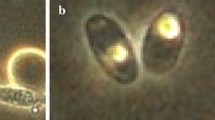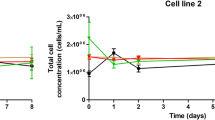Abstract
Multi-parameter flow cytometry was used to monitor cell intrinsic light scatter, viability, and lipid content of Chlorella protothecoides cells grown in shake flasks. Changes in the right angle light scatter (RALS) and forward angle light scatter (FALS) were detected during the microalgal growth, which were attributed to the different microalgal cell cycle stages. The proportion of cells not stained with PI (cells with intact cytoplasmic membrane) was high (> 90%) during the microalgal growth, even in the latter stationary phase, suggesting that the microalgal cells built-up storage materials which allowed them to survive under nutrient starvation, maintaining their cytoplasmic membranes intact. A high correlation between the Nile Red fluorescence intensity measured by flow cytometry and total lipid content assayed by the traditional lipid extraction method was found for this microalga, making this method a suitable and quick technique for the screening of microalgal strains for lipid production, optimization of biofuel production bioprocesses, and scale-up studies. The highest oil content (∼28% w/w dry cell weight, estimated by flow cytometry) was observed in the latter stationary phase. In addition, C. protothecoides oil also depicted the adequate fatty acid methyl ester composition for biodiesel purposes at this growth phase, suggesting that the microalgal oil produced during the latter stationary phase could be an adequate substitute for diesel fuel. Medium growth optimization for enhancement of microalgal oil production is now in progress, using the multi-parameter approach.
Similar content being viewed by others
References
Ma, F. R. and M. A. Hanna (1999) Biodiesel production. Biores. Technol. 70: 1–15.
Patil, V. (2008) The relevance of biofuels. Curr. Sci. 92: 707.
Chisti, Y. (2007) Biodiessel from microalgae. Biotechnol. Adv. 25:294–306.
Chiu, S.Y., C. Y. Kao, C. H. Chen, T. C. Kuan, S. C. Ong, and C. S. Lin (2008) Reduction of CO2 by a highdensity culture of Chlorella sp. in a semicontinuous photobioreactor. Biores. Technol. 99: 3389–3396.
Pulz, O. (2001) Photobioreactors: production systems for phototrophic microorganisms. Appl. Microbiol. Biotechnol. 57: 287–293.
Schenk, P. M., S. R. Thomas-Hall, E. Stephens, U. C. Marx, J. H. Mussgnug, C. Posten, O. Kruse, and B. Hankamer (2008) Second generation biofuels: high-efficiency microalgae for biodiesel production. Bioenerg. Res. DOI 10.1007/s12155-008-9008-8.
Jiang Y., F. Chen, and S. Liang (1999) Production potential of docosahexaenoic acid by the heterotrophic marine dinoflagellate Crypthecodinium cohnii. Process Biochem. 34: 633–637.
Miao, X. and Q. Wu (2006) Biodiesel production from heterotrophic microalgal oil. Biores. Technol. 97: 841–846.
Xu, H., X. Miao, and Q. Wu (2006) High quality biodiesel production from a microalga Chlorella prototehcoides by heterotrophic growth in fermenters. J. Biotechnol. 126: 499–507.
Xiong, W., L. Xiufeng, J. Xiang, and Q Wu (2008) High-density fermentation of microalgal Chlorella protothecoides in bioreactor for microbio-diesel production. Appl. Microbiol. Biotechnol. 78: 29–36.
Li, X., H. Xu, and Q. Wu (2007) Large-scale biodiesel production from microalga Chlorella protothecoides through heterotrophic cultivation in bioreactors. Biotechol. Bioeng. 98: 764–771.
Elsey, D., D. Jameson, B. Raleigh, and M. J. Cooney (2007) Fluorescent measurements of microalgal neutral lipids. J. Microbiol. Methods 68: 639–642.
Tornabene, T. G. (1983) Lipid composition of the nitrogen starved green alga Neochloris oleoabundans. Enzyme Microbiol. Technol. 5: 435–440.
Greenspan, P., E. P. Mayer, and S. D. Fowler (1985) Nile Red: a selective fluorescent stain for intracellular lipid droplets. J. Cell Biol. 100: 965–973.
de la Jara, A., H. Medonza, A. Martel, C. Molina, L. Nordströn, V. de la Rosa, and R. Díaz (2003) Flow cytometric determination of lipid content in a marine dinoflagellate Crypthecodinium cohnii. J. Appl. Phycol. 15: 433–438.
Kimura, K., M. Yamaoka, and Y. Kamisaka (2004) Rapid estimation of lipids in oleaginous fungi and yeasts using Nile Red fluorescence. J. Microbiol. Methods 56: 331–338.
Hewitt, C. J. and G. Nebe-Von-Caron (2001) An Industrial application of multiparameter flow cytometry: assessment of cell physiological state and its application to the study of microbial fermentations. Cytometry 44: 179–187.
Hewitt, C. J. and G. Nebe-Von-Caron (2004) The application of multi-parameter flow cytometry to monitor individual microbial cell physiological state. Adv. Biochem. Eng. Biotechnol. 89: 197–223.
Reis, A., T. Lopes da Silva, C. A. Kent, M. Kosseva, J. C. Roseiro, and J. C. Hewitt (2005) Monitoring population dynamics of the thermophilic Bacillus licheniformis CCMI 1034 in batch and continuous cultures using multi-parameter flow cytometry. J. Biotechnol. 115: 199–210.
Lopes da Silva, T. and A. Reis (2008) The use of multiparameter flow cytometry to study the impact of ndodecane additions to marine dinoflagellate microalga Crypthecodinium cohnii batch fermentations and DHA production. J. Ind. Microbiol. Biotechnol. 35: 875–887.
Miller, G. L. (1959) Use of dinitrosalicylic acid reagent for determination of reducing sugar. Anal. Chem. 31: 426–428.
Lepage, G. and C. Roy (1986) Direct transesterification of all classes of lipids in a one-step reaction. J. Lipid Res. 27: 114–119.
Yeung P. K. K. and J. T. Y. Wong (2003). Inhibition of cell proliferation by mechanical agitation involves transient cell cycle arrest at G1 phase dinoflagellates. Protoplasma 220: 173–178.
Wynn, J., P. Behrens, A. Sundararajan, J. Hansen, and K. Apt. (2005) Single cell oils. pp. 86–98. In: Z. Cohen and C. Ratledge (eds.). Production of single cell oils by dinoflagellates. AOCS press, Champaign, IL, USA.
Premazzi, G., G. Buonaccorsi, and P. Zilio (1989) Flow cytometry for algal studies. Wat. Res. 23: 431–442.
Stauber, J. L., N. M. Franklin, and M. S. Adams (2002) Applications of flow cytometry to ecotoxicity testing using microalgae. TIBTECH 20: 141–143.
Richmond, A. (1986) Handbook of microalgal mass culture. 1st ed., pp. 199–243. CRC Press, Boca Raton, FL, USA.
Choi K. J., Z. Kakhost, E. Barzana, and M. Karel (1987) Lipid content and fatty acid composition of green algae Scenedesmus obliquus grown in cell density apparatus. Food Technol. 11: 117–128.
Illman, A. M., A. H. Scragg, and S. W. Shales (2000) Increase in Chlorella strains caloric values when grown in low nitrogen medium. Enzyme Microbiol. Technol. 80: 749–756.
European Standard EN 14214 (2003) Automotive fuels. Fatty acid methyl esters for diesel engines. Requirements and test methods.
Author information
Authors and Affiliations
Corresponding author
Rights and permissions
About this article
Cite this article
da Silva, T.L., Santos, C.A. & Reis, A. Multi-parameter flow cytometry as a tool to monitor heterotrophic microalgal batch fermentations for oil production towards biodiesel. Biotechnol Bioproc E 14, 330–337 (2009). https://doi.org/10.1007/s12257-008-0228-8
Received:
Accepted:
Published:
Issue Date:
DOI: https://doi.org/10.1007/s12257-008-0228-8




